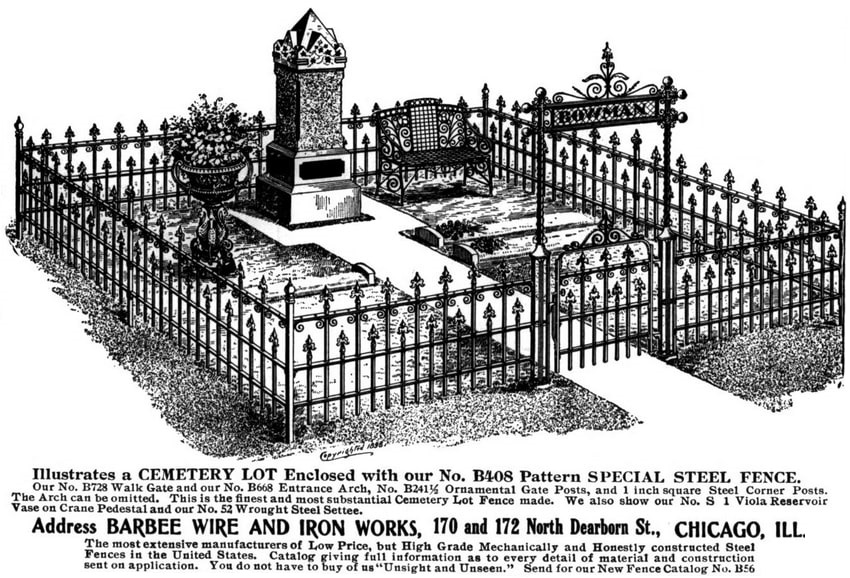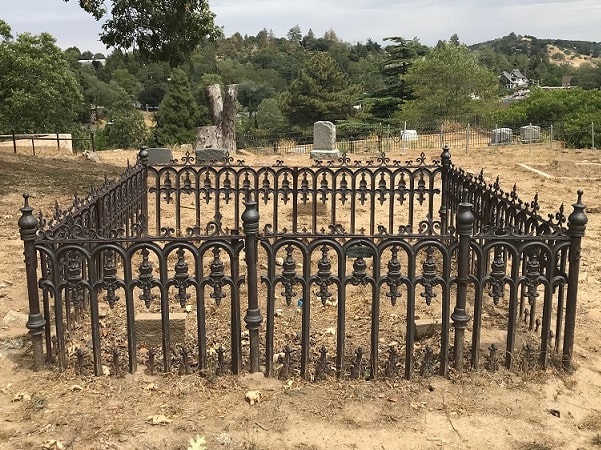Introduction: In this article, Gena Philibert-Ortega writes about a feature you may find at your ancestor’s gravesite: grave guards, or enclosures, protecting the grave. Gena is a genealogist and author of the book “From the Family Kitchen.”
When we think of cemeteries and genealogy we concentrate on the ancestor’s headstone because that’s where the information we need (name, birth and death date) are found. But have you considered other elements of the burial location as you study your ancestor’s death and final resting place?
Where the deceased is buried may provide information about their associations and memberships (church, veteran, or fraternal lodge cemetery, for example). Items adhered to or placed next to the headstone might provide clues to lineage society membership or military service.

When a family purchased a burial coffin and headstone, they could have added additional items such as stone vases, statuary, and benches, as well as protective elements referred to as “grave guards” or “grave protectors.” In addition, cemetery lot or grave fencing might have enclosed one or more graves. (1)
Isn’t a Headstone Enough?
Why did families feel the need to add a grave guard to their loved one’s burial? Actually, after searching historical newspapers, magazines, and catalogs, I found that the reasons given were varied – but they boiled down to protection from the elements (rain, flooding), people, or animals.
Grave guards also provided an additional decorative element at a time when garden cemeteries were a place of beauty, and living family members spent time in these park-like settings. But grave guards and fencing were also important in rustic cemeteries where animals, both domestic and wild, were an issue.
Why did families pay extra to erect a grave guard or fence? Reasons I found in my research were:
- Keep children from picking flowers on the burial site
- Keep people away from the burial site
- Keep animals from digging up the grave
- Keep dogs and cats and other animals off the grave
- Maintain mound shape
- To enclose landscaping provided by family
- Provide a decorative element on its own or to include the headstone/footstone
Bereaved families could purchase grave guards through metal, wire, and stone manufacturer catalogs, local retailers, and yes, even the Sears catalog. It’s also possible families created something similar with fencing made out of wood or pipes.
Newspaper advertisements for grave guards can be found starting in the 1870s. Manufacturers of grave guards also sold other non-cemetery products to the community, such as fencing and statuary.
A search of patents provides an idea of some of the various designs available. Patents for grave guards were still being submitted into the first decades of the 20th century. You can see various improvements to the basic grave guard by searching Google Scholar using the key words “grave guard.”
Descriptions and Types
Stone and fencing manufacturers made cemetery lot fencing and grave guards. One manufacturer, Amos Rank & Co. from Salem, Ohio, described its products this way: “Rank’s Patent Grave-guards are intended for guarding the graves, also for the receptable of head and foot stones. They are made of metal, cast in suitable molds, painted or enameled, as may be ordered, of different styles and sizes.” (2)
Here is a newspaper advertisement for Rank’s grave guards.
The Smithsonian blog Unbound provides some images of Rank’s catalogs and explains that:
“Rank’s Grave Guards protected the grave, gave it symmetry, and helped to keep the headstone and footstone standing upright. It consisted of a low wall surrounding the burial mound. At either end, there were standard-sized rectangular slots to place the headstone and footstone in securely.” (3)
As you explore older cemeteries you may find examples of these – or what’s left of some of the designs. Some of the fencing included trellises to hold hanging plants or vines. In some cases, the grave guard has an open element in the middle for planting flowers, grass, or other plants. Not all grave guards include a cut-out for the headstone and footstone, but you may see this as well.
Cemetery Fashion
Over time, perhaps by the mid-twentieth century, the use of these grave enclosures appears to have fallen out of favor. Some cemeteries banned them outright, and public discussion over the “look” of cemeteries included discussion of fences and grave guards.
This 1913 Ashland, Oregon, newspaper column discusses how cemeteries could be beautified, stating:
“Inclosures [sic] around burial lots, grave guards and trellises should be considered useless encumbrances, and should therefore be forbidden.”
A search in GenealogyBank’s Historical Newspaper Archives provided other examples of cemetery rules that aim at cemeteries keeping a consistent look, including the banning of grave guards and cemetery lot fencing. While grave guards aren’t something our more recent family would have included in their final resting places, these older examples provide insight into the burials of our ancestors.
Note on the header image: photo of a grave guard at Julian Pioneer Cemetery, Julian, California. Credit: Gena Philibert-Ortega.
________________
(1) Researchers might be familiar with mortsafes that were used to protect graves from grave robbers in countries like Scotland. These heavy metal jail-like cages were put over burials and sometimes removed and reused. Their purpose was temporary, to deter grave robbers looking for new burials. While some grave guards would make grave robbery impossible, these were sold for other reasons and were decorative.
(2) “Ohio, the future great state, her manufacturers, and a history of her commercial cities, Cincinnati and Cleveland,” available via FamilySearch Digital Library, p. 443 https://www.familysearch.org/library/books/records/item/228563-ohio-the-future-great-state-her-manufacturers-and-a-history-of-her-commercial-cities-cincinnati-and-cleveland?viewer=1&offset=10#page=527&viewer=picture&o=info&n=0&q=grave%20guards
(3) “Guarding the Graves,” Unbound (https://blog.library.si.edu/blog/2017/10/30/guarding-the-graves/#.Ya5gM9DMKUk: accessed 6 December 2021).
Related Articles:
